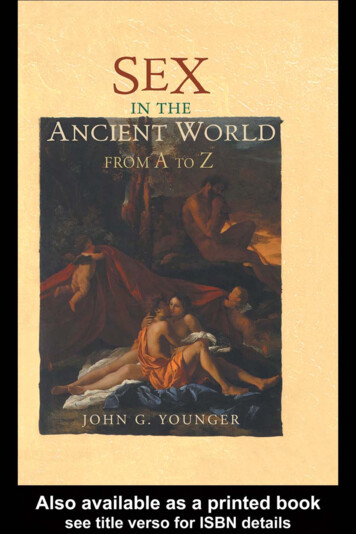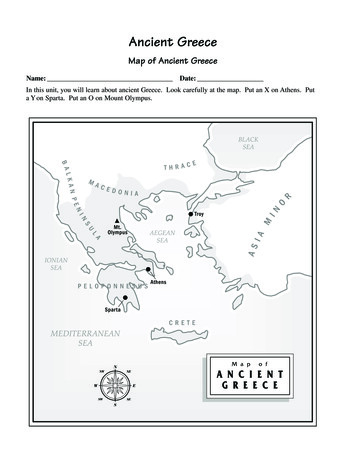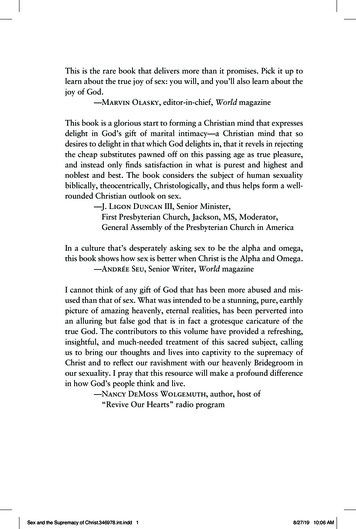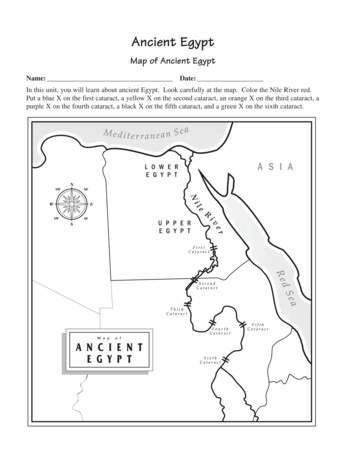
Transcription
SEX IN THE ANCIENT WORLDFROM A TO Z
THE ANCIENT WORLD FROM A TO ZWhat were the ancient fashions in men’s shoes? How did you cook a tunny or spicea dormouse? What was the daily wage of a Syracusan builder? What did Romansuse for contraception?This new Routledge series will provide the answers to such questions, which are oftenoverlooked by standard reference works. Volumes will cover key topics in ancient cultureand society—from food, sex and sport to money, dress and domestic life.Each author will be an acknowledged expert in their field, offering readers vivid,immediate and academically sound insights into the fascinating details of daily life inantiquity. The main focus will be on Greece and Rome, though some volumes will alsoencompass Egypt and the Near East.The series will be suitable both as background for those studying classical subjects andas enjoyable reading for anyone with an interest in the ancient world.Already published:Food in the Ancient World from A to ZAndrew DalbySport in the Ancient World from A to ZMark GoldenSex in the Ancient World from A to ZJohn G.YoungerForthcoming titles:Birds in the Ancient World from A to ZGeoffrey ArnottMoney in the Ancient World from A to ZAndrew Meadows
Domestic Life in the Ancient World from A to ZRuth Westgate and Kate GilliverDress in the Ancient World from A to ZLloyd Llewellyn-Jones et al.
SEX IN THE ANCIENT WORLDFROM A TO ZJohn G.YoungerLONDON AND NEW YORK
First published 2005 by Routledge 2 Park Square, Milton Park, Abingdon, Oxfordshire, OX144RNSimultaneously published in the USA and Canada by Routledge 270 Madison Ave., New York,NY 10016Routledge is an imprint of the Taylor & Francis GroupThis edition published in the Taylor & Francis e-Library, 2006.“To purchase your own copy of this or any of Taylor & Francis or Routledge’s collection ofthousands of eBooks please go to www.eBookstore.tandf.co.uk.” 2005 John G.YoungerAll rights reserved. No part of this book may be reprinted or reproduced or utilised in any form orby any electronic, mechanical, or other means, now known or hereafter invented, includingphotocopying and recording, or in any information storage or retrieval system, without permissionin writing from the publishers.British Library Cataloguing in Publication Data A catalogue record for this book is available fromthe British LibraryLibrary of Congress Cataloging in Publication Data A catalog record for this title has beenrequestedISBN 0-203-33807-3 Master e-book ISBNISBN 0-415-24252-5 (Print Edition)
TO PAUL
ContentsList of illustrationsixPrefacexiiAcknowledgmentsxvTheory and modern scholarshipxivSEX IN THE ANCIENT WORLD FROM A TO Z1Bibliography222Ancient sources cited239Works of art cited303Index325
IllustrationsPlates1Etruscan terracotta sarcophagus (6th c. BCE; Villa Giulia; 109).2Etruscan marble sarcophagus lid (late 5th c. BCE; BMFA; 110).3Red-figure hydria (early 5th c. BCE; Villa Giulia 50635; 110).4Chieftain Cup from Haghia Triada (ca. 1550 BCE; HM; 111).5Red-figure kylix by Makron (early 5th c. BCE; Toledo; 111),exterior.6Red-figure kylix by Douris (early 5th c. BCE; BM E768; 112),interior.7Red-figure pelike (early 5th c. BCE; Mykonos; 112).8Black-figure dinos (late 6th c. BCE; Vatican 35605; 113).9Tombstone, Pharsalos (early 5th c. BCE; Louvre; 113).10 Red-figure kylix, Apollodorus (early 5th c. BCE; Tarquinia; 114).11 Red-figure bell krater, Louvre G521 Ptr (late 5th c. BCE; Vatican9098; 114).
12 Marble tombstone from Piraeus (late 5th c. BCE; Piraeus; 115).13 Red-figure kylix, Peithinos (early 5th c. BCE; Berlin,Charlottenburg; 115).14 Mosaic from El Jem (2nd c. CE; El Jem A16; 116).15 Marble statue of Pan from Athens, Olympieion (4th c. BCE; NMA;117).16 Marble statue of Antinoös from Chalkis (early 2nd c. CE; Chalkis;118; photo by Paul Rehak).17 Terracotta uterus (2nd–1st c. BCE?; University of Kansas; 119).18 Terracotta vulva from Cività Castellana (2nd–1st c. BCE?; CivitàCastellana; 120).19 Entrance mosaic from the House of Jupiter the Thunderer, Ostia (1st–2nd c. CE; 121).20 Mosaic from Sousse (2nd–3rd c. CE; Sousse; 122).21 Phallus-shaped drinking vessel from Pella (3rd c. BCE; Pella; 122).22 Red-figure kylix (mid 5th c. BCE; Villa Giulia 50404; 123).23 Discus lamp from the Cave of Pan, Attica (1st c. CE; NMA; 123).24 Discus lamp from Sparta (1st c. CE; Sparta; 124).25 Discus lamp from Messene (1st c. CE; Messene; 210).26 Mould for a mould-made bowl from Pella (Hellenistic; Pella; 210).27 Mosaic from Sousse (2nd–3rd c. CE; Sousse; 211).28 Marble statue of Aphrodite, the “Knidia” by PRAXITELES (mid-4thc.; 212).
29 Marble statue group of Aphrodite, Pan, and Eros from Delos (3rd–2nd c. BCE; NMA; 213).30 Painting from the House of the Marine Venus, POMPEII (1st c. CE;214).31 Mosaic from Maktar, Tunisia (2nd–3rd c. CE; Maktar; 214).32 Mosaic from El Jem, Tunisia (2nd–3rd c. CE; El Jem; 215).33 Painting from the House of the Vettii, POMPEII (1st c. BCE–1 c.CE; 215).34 Mosaic from El Jem, Tunisia (2nd–3rd c. CE; El Jem; 216).35 Marble hermaphrodite reclining on a (restored) couch, face (Rome,Altemps; 216).36 Marble hermaphrodite reclining on a (restored) couch, genitals(Rome, Altemps; 217).37 View of the latrine, Forum baths, Ostia (pp. 22, 27, 217).38 Reconstruction painting by G.Marsigli of the paintings on thetablinum north wall, House of Cæcilius Jucundus, POMPEII (p. 218).39 General view of the peristyle garden, House of the Vettii, POMPEII(p. 218).40 General view of the southeast triclinium, House of the Vettii,POMPEII (p. 219).41 Red-figure kylix, Foundry Ptr.? (early 5th c. BCE; Tarquinia 5291;219)42 Marble statue of Nero (Thessalonike; 220).43 Silver “Warren” cup (1st c. CE; BM; 221)
PrefaceThe contents of this bookThis encyclopedia concentrates on the sexual practices, expressions, and attitudes of theGreeks and Romans in the lands around the Mediterranean in the period between 1000BCE and 300 CE; occasionally it will stray into peripheral cultures, into times earlier andlater, and into subjects that may not seem like sex at all.Sex and sexuality are difficult to define. In English, “sex” denotes primarily thebiological sex of a person (male, female, other; in Greek and Latin, one’s genus); genderis the way a person is expected to act in society because they are male or female. Sexsecondarily means activities that involve the genitals and related body areas. Sexuality ismore personal and seems to allude to the individual’s promise of or availability for sexualactivity. Behind this personal quality lies, however, the social construction of sexuality,how society views sex and the individual.For some ancient cultures, sexual practices are virtually invisible (Celtic and MinoanMycenaean). Greeks and Romans, however, depicted and wrote about sex candidly andconstantly. In general, sex was for procreation, recreation, and political advancement.Within this broad spectrum, details of ancient sex sometimes seem peculiar. For instance,their favorite position for intercourse was rear entry (“a tergo”); they thought ravensconceived their young through fellatio; they put phalluses everywhere (indoors andoutdoors) for good luck; Greeks and Romans (men and women) used their slavessexually; and both Greeks and Romans made their politicians out to be sex-crazedprofligates. In other words, Greeks and Romans were not sexually repressed.I have tried to keep this encyclopedia focused on specific ancient subjects: people,behavior, and attitudes, words, works of literature, depictions, artifacts. I have tried tofocus more on sex and less on gender. I have tried to keep the entries factual, without toomuch over-interpretation; sometimes, however, the evidence warrants a more interpretivestatement. I have also avoided illustrating those objects that are commonly found inhandbooks (see Works of art cited). Our sources for classical sex and sexuality arelimited in several ways. Most ancient writings have been lost due to neglect, to thepractice of anthologizing texts for teaching, to the male bias against the writings ofwomen, and to the prudish Bowdlerism of late and post-antique scholarship. Much of our
artifactual evidence was deliberately lost or locked away in “secret cabinets” and“curiosity collections,” which only recently have been opened for a more appreciativeand tolerant public. For instance, the Naples Museum had a “Gabinetto degli OggettiOsceni” (Cabinet of Obscene Objects) which it has now opened to the public as the“Raccoltà Pornografica” (Pornographic Collection). It is still, however, a separatecollection, reflecting our tendency to see sex apart from the rest of culture.Because almost all of our sources are male-authored, it is difficult to obtain a balancedview of men’s and women’s sexuality, sex practices, and desires. Nonetheless, it is wellworth the effort. For instance, though representations of vaginas are rare, one womandedicated a sculptural representation of hers “to Aphrodite, for her favors: rejoice all youpassers-by!”TerminologyI have tried to keep the terminology unoffensive; I have occasionally used an Englishobscene expression, but only to translate the force of the ancient one. If my vocabularyseems dry, perhaps it will help the reader concentrate on the differences between ancientand modern practices and behaviors.Similarly, I have tried not to use a vocabulary that is inappropriate for describing whatthe ancients did and thought. Most men were, and were assumed to be, attracted to bothyoung women and boys and almost all got married. Within these parameters, the term“bisexual” is inappropriate. The term “heterosexual” applies only to those few men (likeOvid and Claudius) who liked women (almost) exclusively. In some instances, it ispossible to show women’s “heterosexual” desires for men, but for others a “lesbian”desire is more appropriate. Similarly, men who were attracted to boys and youths will bediscussed under Greek “paiderastia,” which is an anthropologically attested, eroticizedmale socialization ritual, and under Roman “boy-love,” which citizen men felt almostexclusively for youthful non-citizen males. For those few men who maintained same-sexrelationships into adulthood, I use the term “male homosexual.”The following are terms found throughout this book:agoramarket place (Greek)archona high city magistrate“a tergo”sexual penetration from the rearerastesthe older “lover” in a paiderastic relationshiperomenosthe younger “beloved” in a paiderastic relationshipephebemilitary cadet (18–20 years old, in Athens)hetairaexpensive prostituteforummarket place (Roman)metica foreign residentpallakê/ósconcubine (female, male)
pornêinexpensive prostitutetyranta dictator, usually favorably disposed toward the merchantclass, of the early Greek periodNotes to readersThe names of Greek authors are given in conventional Latinate spelling; words and othernames follow Greek spelling unless well known.Internal references will appear in small capitals, both the proper title of the entry andvariations (thus, both PROSTITUTED and PROSTITUTION refer to the entryPROSTITUTES).Dates are specified as BCE or CE; dates of authors are given in the “Ancient sourcescited” section at the end of the book.Bold numbers in the entries refer to the items in the “Works of art cited” section at theend of the book.Quotations are abbreviated; the intention here is not to mislead the reader but to makethem more readable. All translations are the author’s, unless otherwise stated.Much information has been drawn from basic, unreferenced sources like LIMC, OCD,RE, Hubbard 2003 (see Bibliography); and the “Perseus” online website(http://perseus.tufts.edu).
AcknowledgmentsI wish to thank the students in my courses on Perspectives in Lesbian, Gay, Bisexual, andTransgender Studies at Duke University, on Gender and Sexuality in the Ancient Worldat both Duke University and the University of Kansas, and on Classical Women Writersat the University of Kansas—and special thanks to Brian Walters, Susanne Fletcher,Christina Ponig, and Cara Snyder. As always, I am grateful to Paul Rehak who read thismanuscript, heard my thoughts, and gave me many suggestions, criticisms, and somedifficult questions. Paul passed away while this book was in press; I dedicate it to him inloving memory and in memory of our love.
Theory and modern scholarshipTheoriesEssentialism and constructionismEssentialism holds that human beings have in-grained behaviors and attitudes.Constructionism holds that some behaviors are dependent on the particular society, time,and place. What about sex? Is it “natural”? Is it socially constructed? For instance,western civilization prefers the “missionary” position (woman supine, man on top, forfacing vaginal intercourse; Marks 1978); but classical society preferred intercourse “atergo” (SEXUAL POSITIONS).If the preference for a sexual position has changed, what about other preferences? Forinstance, there was greater tolerance for homoerotic behavior in antiquity. Was theretherefore “homosexuality” in antiquity? Some scholars say “no” (the term was onlycoined in 1869; see Padgug 1989:60; Halperin 1990, 1994; Halperin et al. 1990). A fewscholars (like Boswell 1980 and 1994), however, have identified what look like modernhomosexuals and modern homosexual behavior in antiquity (cf. ARISTOPHANES’Smyth in PLATO’S SYMPOSIUM 191d–193a). I am convinced by this evidence, that themodern concept of homosexuality was more or less known in antiquity but rarelypracticed (MALE HOMOSEXUALITY; LESBIANISM). If so, then it is the practice thatis constructed, not the basic desire (Stein 1999).Penetration dominationIn the late twentieth century it became fashionable to assume that penile penetrationexpressed the power of the penetrator and the subordination of the penetrated (Foucault1976/80–1984/6; Keuls 1985; Parker 1992). Many studies then concluded, rightly I feel,that men had sexual access to all those beneath them in society (unmarried females, noncitizen males, slaves; Richlin 1992:xviii; Sutton 1992:5); only proper women and citizenmales were off limits.
The assumption turns on the subordination of the penetrated. My own experience as agay man tells me, however, that who has power during sexual activity can be negotiated.For instance, the penetrated could exercise control. We hear how LAIS 2 so perfected the“a tergo” technique that she called the posture her own, the léaina (the lioness). Thesecond most popular sexual position, the equestrian, had the woman on top where shecould control sexual stimulation (cf. Johns 1982:136–7; Myerowitz 1992:153). And inRoman practice there were two kinds of oral-penis stimulation, fellatio (performed by themouth of the penetrated) and irrumation (performed by the penis of the penetrator [i.e.rape of the mouth]). The Romans therefore distinguished between who had control of thesexual stimulation, the penetrator (irrumatio) or the penetrated (fellatio).The origin of homosexualityMany scholars have written much about early paiderastia—since Homer does notmention it, some scholars argue that it must be an innovation of the later Iron Age.Scholars then look for causes (population control [Percy 1996], or a byproduct of athleticnudity [Scanlon 2002]). Paiderastia, however, is not homosexuality; it is a coming-of-agerite, and as such it has anthropological parallels that situate it in a stage of stateformation, at the tribal level. In that case, paiderastia should originate in the Bronze Age(Cantarella 1992:5), and I myself would put its development no later than the MiddleBronze Age (ca. 1900–1600 BCE).Men and womenIn antiquity men and women saw each other as different; accordingly, they developedcomplex taxonomies (philosophical explanations) for understanding anatomical,physiological, emotional, and rational differences. Some of these differences seemprofoundly odd to us moderns. For instance, women had many pockets in their body thatneeded to be broken through to (hence the necessity for penetrative intercourse) andwomen’s bodies were moist (hence the need to menstruate); conversely, men’s bodieswere dense (hence the need for physical exercise) and hot and dry (hence the need to stayactive and outdoors).In modern society, masculinity is primarily performed as a set of repeated androutinized behaviors (men are taught to be “tall, dark, handsome, restrained, strong,unemotional”). Femininity is also performed, but with seemingly greater variety (womenare taught to be “flighty, indecisive, emotional, and conscious of appearance”). Inantiquity we find similar performances: women’s thoughts and emotions are fluid, men’scontrolled.With women constructed as closer to unmanageable nature (Aristotle, Problems 29;Ortner 1972), men may have felt constantly in danger: surely spending too much timewith women emasculates a man. Not coincidentally, therefore, we occasionally hear menlamenting that women are necessary for procreation (SEXUAL ATTITUDES).
Erotic art and pornographyModern discussions about erotic art have often concerned the place of women: to whatextent are they objects of social manipulation, to what extent can they be subjects? Sincemen probably made most art and most literature, many scholars have concluded thatancient women are basically unknowable (Rabinowitz 1992:38–50; Kappeler andMacKinnon 1992:252).As an archaeologist, however, I feel that too much emphasis has been placed onliterature and not enough on the artifactual evidence. Women viewed erotic art; theyundoubtedly saw the Greek sympotic drinking cups and contemplated the wall paintingsin their Roman homes. And in doing so, they must have speculated on their ownsexuality.Much of the debate over pornography concerns two issues: its objectification of allparticipants and the effects of that objectification. Will erotic objectification cause people(men) to objectify their actual partners during sex, or will pornography cause a catharsisof such (negative) feelings? Since homosexual pornography is rampant today buthomosexual rape is rare, homosexual pornography (at least) may have little negativeeffect on behavior (Shapiro 1992:55).Moral decayA common attitude in antiquity was that toleration of immoderation (luxury, food, drink,sex) would induce cultural decline. That culture has declined is an assumption in Hesiod,and that present laxity overturns accepted morality is a theme in Aristophanes’s Clouds.Writers constantly accused politicians and other notables for sexual perversity(INVECTIVE). “A well-known theme of Latin literature locates the initiation of thestate’s supposed moral ruin in the second century BC, and attributes that decline to theinflux of wealth from the East” (Wyke 1994:140). LAWS were enacted to stem theerosion of public decency (BACCHANALIA). In the Justinianic codes, sexualimmorality was an offence to God, and since God could exact revenge on the state, thestate’s punishment was capital.For sexual morality, the topic turned, and still turns, on the participants (whatbiological sex, what class, what age), activities (what positions, penetrations of what),and reasons (procreation, pleasure, political ambition). All these factors are subject toscrutiny, especially along lines of what is considered “natural” (SEXUAL ATTITUDES),as if human behavior had any “natural” analog. As Winkler (1990:17–44) clearly saw,what is “natural” in human behavior is usually cultural. For antiquity, I take no moralstance; they practiced sex because they could.
Modern scholarshipBy the late eighteenth century Greek culture was being castigated for inspiring“pederasty” (“Greek,” “Socratic” love). In the early nineteenth century Friedrich Welcker(1816 [1845]) made a strong case for Sappho as a heterosexual, ideal mother, whichbrought Sappho’s poetry back into the classical canon. William Mure (1857) demolishedWelcker’s view, opening the dialogue on ancient sexual behaviors. John AddingtonSymonds published privately two essays (1883, 1891) that discussed Greek paiderastiaand the characterization of modern homosexuality. Early twentieth-century scholars thustried to approach Greek and Roman sexuality with some objectivity (Licht 1925–8, 1932;Vorberg 1932).In the late twentieth century lavishly illustrated books (e.g. Marcadé 1962 and 1965;Grant and Mulas 1965; Boardman and LaRocca 1975; Johns 1982) allowed an interestedpublic to examine ancient erotic art leisurely; and Brendel 1970 discussed it incomfortable art historical terms. Michel Foucault (1976/ 80–1984/6) systematized ancientsexuality as a (male) cultural construct (with a history), at the same time feminist scholarsbegan recovering ancient women and their sexuality (Pomeroy 1975; Keuls 1985).Wilhelm Krenkel’s remarkable series of articles (1979–89) on ancient sexual practiceswent unduly neglected, but they deserve careful reading. Ancient homoeroticism was amajor theme in the 1980s (e.g. Boswell 1980; Lilja 1983; Koch-Harnack 1983; Reinsberg1989; Dover 1989).From 1990 to the present day ancient sexuality has gone mainstream, being offered inuniversity classrooms and quoted in America’s lawcourts (Nussbaum 1994; Skinner1996; and the 2003 Supreme Court decision that overturned sodomy laws). Especiallyinfluential studies include Lefkowitz and Fant 1992; Richlin 1992; Dean-Jones 1994;Kampen 1996; Clarke 1998; and Davidson 1998.
AAbortionSince conception was considered a continuous process (seven days for Aristotle or longerfor SORANUS), and since it was also unclear when life began (at conception[Pythagoreans], at birth [Diogenes, Stoics], or gradually through PREGNANCY[Soranus]), CONTRACEPTION and abortion are conflated in antiquity.Methods of abortion (ekbólia) include drugs to stimulate blood flow (oral pessaries orexternal poultices; PLANTS), strenuous activity (DANCE), physical interventions, andMAGIC. Elephantis (first century BCE) was a well known woman author onabortifacients (Pliny, HN 28.51).Abortions for female slaves and PROSTITUTES were common (Hippocrates, Nat.puer.); the BROTHEL at Ashkalon produced many fetus skeletons in its drains (Faerman1998). Abortions for citizen women, however, were avoided since they gave women apower over their own bodies (OVID, Amores 2.13–14) and bypassed the father’s right toaccept the child into the household (AMPHIDROMIA). After Augustus’s LAWSpromoting MARRIAGE and multiple children, people began to consider the fetus theprimary victim of abortion.The statement in the Hippocratic oath, “I will not give to a woman a pessary toprocure an abortion,” does not forbid other means and does not specify when thisprohibition should apply; consequently, doctors made their own decisions based onindividual cases.Abortion was apparently not illegal in antiquity, nor was it hateful to the GODS.Under Septimius Severus and Caracalla a few cases criminalized abortion because thehusband did not consent. The Digest mentions abortion only because of dangerous drugs(48.19.38.5).See also: CONTRACEPTION; MEDICINE.Richlin 1997:237–9; Kapparis 2002.
Sex in the ancient world from A to Z2Abstinencewas a man’s concern in antiquity (except in ARISTOPHANES, Lysistrata). In general, itwas thought to preserve potency. Continence contributed to good health, allowing a man“to store up his seed” (Plutarch, Mor. 129d ff.). Prolonged abstinence, however, could doharm. “Athletes or singers who lead totally sexless lives have thin and wrinkled genitalslike OLD men’s” (Galen 8:451–2 Kühn). In contrast, Aristotle (Gen. An. 7.1) notes thatthe male voice deepens during puberty and with SEXUAL ACTIVITY.Abstinence from intercourse was practiced by singers (Horace, Ars P. 414; cf.Suetonius, Domitian 10), although they could perform FELLATIO and CUNNILINGUS(Aristophanes, Knights 1278 f., and scholiast; Juvenal 6.73; Martial 7.82, 11.75, 14.215).ATHLETES especially abstained from sex, since any loss of SEMEN sapped strength.“If any man retains his semen, he is strong, and the proof is athletes who are abstinent”(Aretaeus, De causis morb. 2.5.4; cf. Plato, Laws 839e–840c). Athletes were advisedeven to avoid MASTURBATION and NOCTURNAL EMISSIONS by wearing leadplates under their thighs (Galen 9:12, 12:232 Kühn; cf. NERO). Modern admonitionsagainst masturbation often address adolescents: it depletes “the sex fluid formed by thetesticles. Keep control in sex matters. It’s manly to do so. It’s important for one’s life,happiness, efficiency and the whole human race as well” (Boy Scouts of America1910:448–9). And modern coaches discourage sex especially on nights beforecompetition.Both Plutarch (Anecd. Par. 2.154.20–25) and Aelian (NA 6.1) mention the Olympicpankratiast Kleitomachos who “turned away when he saw dogs mating” (Aelian) and“did not tolerate the mere mention of sex” (Plutarch). Aelian also characterizes theOlympic pentathlete Ikkos (444 BCE) as “inexperienced in sexual intercourse for thewhole period of his training, for Ikkos was in love with the Olympic and Pythian Games”(cf. Plato, Laws 839e–840a).To help them avoid DESIRE, athletes rubbed their bodies with an ointment thatstained the skin yellow; Philostratus’s description (“oil thickened with dust,” Gym. 31–40) implies that this is KONISALOS (cf. Martial 7.32.9, 11.47.1–8). Other means forreducing desire included anaphrodisiacs (APHRODISIACS), CHASTITY BELTS, andthe DOGKNOT.See also: BODY MODIFICATION.Sweet 1985; Scanlon 2002:227–36.Achilles,son of Peleus and Thetis, hero of the TROJAN WAR. Since Achilles was willing tochoose a short but famous life, Thetis hid him, when Agamemnon was assembling hisTrojan expedition, at the court of Lykomedes on the island of Scyros, dressed as a girl
Sex in the ancient world from A to Z3(AGE GRADES, TRANSVESTISM). There he has a son, Neoptolemos by Deidameia,one of the king’s daughters. Odysseus and Palamedes arrive to look for him, andOdysseus drops armor on the floor to attract Achilles’s attention. Thus found out, he joinsthe expedition. At Aulis, to assuage ARTEMIS, Agamemnon sacrifices his daughterIphigeneia on the pretext of MARRYING her to Achilles (cf. VERGINIA). At Troy,Achilles ambushes and kills Troilos by either cutting off his head or raping him to death.At the start of the Iliad, Achilles is forced to give up his prize, Briseis, to kingAgamemnon. He sulks in his tent, but his best friend Patroklos dons Achilles’ armor andis killed by Hector. In poems that deal with later events, Achilles kills Penthesileia queenof the AMAZONS, but only seconds after they had fallen in love at first sight(NECROPHILIA). After Paris kills Achilles, Polyxena is sacrificed to him.Achilles may also have been the eromenos of Antilochos (Homer, Odyssey 24.78–9;cf. 40). In Homer, Patroklos is older than Achilles, and the two are just friends.Aeschylus (Myrmidons fr. 228 Mette) and Plato (Symp. 180a.4), however, make Achillesthe elder erastes and Patroklos the younger eromenos (89, 166).Adonis, the son of Cinyras, king of Cyprus, and of Cinyras’s daughter Myrrha who had seducedhim (INCEST). Myrrha then became the myrtle tree (fruiting in mid-June) out of whichwas born Adonis (myrton, clitoris; cf. ATTIS). APHRODITE seduces him. A boar killshim and she keeps the body fresh with nectar (cf. Nossis, Greek Anth. 6.275) or changeshim into a flower, the adonium.Women mourn his death annually in Athens and Argos at the Adonia (mid-June?;Ammianus 22.9.15). They force PLANTS to sprout (the Gardens of Adonis) and carrythem to rooftops where they wither. The festivities on the rooftops were raucous (Oakleyand Sinos 1993:40). Finally, the women carry an image of Adonis around the city andcast it in the sea. The “Mutilation of the HERMS” and the departure of the Syracusanexpedition of 415 BCE took place during the festival (Plutarch, Alc. 18).Ovid, Met. 10.519–36; Apollodorus 1.3.2; 1.9.9, 11 and 12; 3.14.3 and 4; Pausanias2.20.6; 6.24.7; 9.16.4; 9.29.8; 9.41.2; Keuls 1985:391, 395; Reed 1995; Simms 1997;1998.Adulteryassumes that one spouse is the property of the other, used without approval by anotherperson; additionally, an adulteress betrays her lawful guardian (Wells 1979). Most
Sex in the ancient world from A to Z4adultery in antiquity is committed by the wife, although ALCIBIADES’S wife tries todivorce him for letting PROSTITUTES stay in the house.In Athens, if the husband catches his wife in the act of adultery, he may kill the otherman with impunity (cf. Lysias, Eratosthenes), although the usual penalty was to paymoney to the husband (Callias 1 K-A). There were other punishments against the maleadulterer: stuffing a radish or mullet into his anus, or irrumating him (FELLATIO;Aristophanes, Clouds 1079–85; Catullus 15, 74; Martial 2.47.4). Seducers of unmarriedwomen, however, could be forced to MARRY them. Adulterous wives in Athens weredenied access to public festivals, displayed in the agora, or led through the city bound.In Rome, a husband, in consultation with his wife’s relatives, could kill his wife foradultery, drinking, counterfeiting his keys, or poison (Dio. Hal. 2.25; Plutarch, Rom. 25).In 36 BCE a man caught his wife in bed with another woman, and he killed them both(Plutarch, Ant. 24.5; Strabo 660; LESBIANISM). The lex Julia de adulteriis coercendis(18 BCE; LAWS) defined criminal adultery as involving a married woman.Husbands could allow their wives to be seduced by someone important for politicalgain. Phaüllos of Argos sneaked his wife to king Philip V.Gabba gave a dinner forMaecenas and pretended to go to sleep so he could dally with his wife; when a slaveattempted to steal some wine, Gabba blurted, “it’s only for Maecenas that I’m asleep!”paraphrasing Lucilius 251 (Plutarch, Erotikos 760a–b cites both stories).See also: DIVORCEAeschines(ca. 397–22 BCE), Athenian politician. In 346/5, Demosthenes, supported by Timarchus,prosecuted Aeschines for bribery, and Aeschines successfully counter-prosecutedTimarchus for PROSTITUTING himself (Aeschines,
Mycenaean). Greeks and Romans, however, depicted and wrote about sex candidly and constantly. In general, sex was for procreation, recreation, and political advancement. Within this broad spectrum, details of ancient sex sometimes seem peculiar. For instance, their favorite position for intercourse was rear entry ("a tergo"); they thought .










